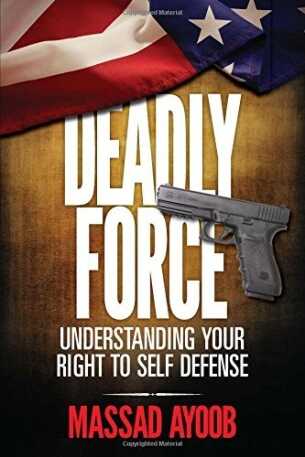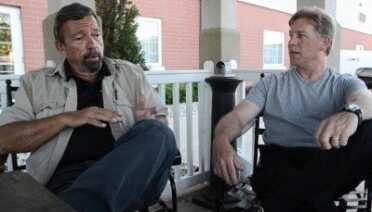You are legally carrying a concealed handgun. You have your permit, took your requisite training, and picked out a nice holster. But how do you know when you can use this lethal tool for the protection of yourself or others? When is it okay – and when is it not okay?
These are the questions that a 12-year old Massad Ayoob asked himself when he was minding the family store with a loaded 1911 tucked into his waistband. Luckily for us, he didn’t just ponder those questions – he asked others. Policemen and judges, his father and grandfather, and other knowledgeable and thoughtful people. I don’t think Mas would mind me telling you that was over 50 years ago – and it put him on the course of his life’s work, reflected in the subtitle of his newest book, “Deadly Force: Understanding Your Right To Self Defense”.
When I am complaining about other drivers (which is hardly ever, just ask my wife) I often point out that people are taught in driver’s education how to operate a motor vehicle – they are not taught how to drive! That knowledge comes from good advice from friends and family, personal experience, and above all a desire to be better at it. In many ways, I feel the same about the required training that many individuals take, either compulsory or voluntary, to obtain their concealed carry permit. The classes are usually structured to ensure that you understand the safe handling and use of your handgun, have a better than average knowledge of the laws of your state, and that you can demonstrate a set standard of marksmanship. All very important and crucial, to be sure – but that should just be the beginning.
And that is where Massad Ayoob comes in – and has since the 1970’s when he wrote the ground breaking book, In the Gravest Extreme, considered by most (this author among them) to be the first significant book to address the topic of the armed citizen and the ‘rules of the road’ for self-defense. Mas’ newest book, Deadly Force is much more than just a continuation of that discussion. Adding depth and knowledge learned in the past four decades, Mas clearly articulates the critical information you need if you carry a firearm or keep one in the home for defense. The book also contains case studies that take a deep look into real self-defense shooting cases and apply the principles previously discussed to these important real-world examples. The case of Florida vs. Zimmerman is examined in detail, in a way that only Mas Ayoob can – and we are finally allowed to understand how the law was applied.
 Deadly Force begins by presenting some fundamental definitions and understanding. Most of us only know of the law what we see on TV, which is most often very far from reality. Mas guides us through the legal jargon and standards and presents them in plain terms. Terms that are crucial for the armed civilian to know and understand. What factors must be present to warrant the judicious use of deadly force? You’ll know them after you read this book. Does your attacker have to be armed? Does it have to be a gun? At what distance is a thug with a knife considered a deadly threat? What things could occur during a struggle to change the threat from non-lethal to lethal? Do these questions intrigue you? If so, you’ll be having “ah-ha” moments with each turn of the page.
Deadly Force begins by presenting some fundamental definitions and understanding. Most of us only know of the law what we see on TV, which is most often very far from reality. Mas guides us through the legal jargon and standards and presents them in plain terms. Terms that are crucial for the armed civilian to know and understand. What factors must be present to warrant the judicious use of deadly force? You’ll know them after you read this book. Does your attacker have to be armed? Does it have to be a gun? At what distance is a thug with a knife considered a deadly threat? What things could occur during a struggle to change the threat from non-lethal to lethal? Do these questions intrigue you? If so, you’ll be having “ah-ha” moments with each turn of the page.
What about legal concepts like Castle Doctrine and Stand Your Ground? Yep – covered in this book. Mas Ayoob has been a foremost expert witness in defensive shooting cases for decades, and he provides us with a clear definition of these concepts that are so often twisted and distorted by the media. After providing the reader a far better understanding of Castle Doctrine and Stand Your Ground, Mas takes the reader on a journey through our age’s most publicized self-defense case: The Zimmerman Case. What you will learn about this case will astound you, if all you’ve previously been exposed to is the media’s version and water cooler conversations. You’ll learn facts you didn’t know, and how the law applies to the various situations and elements of the case. Mas has demonstrated time and again in courtrooms the ability to let a jury “get it” when it comes to self-defense. His ability to communicate complex and uncomfortable subjects in simple and no-nonsense terms is one of the best reasons to read this book.
The decision to carry a concealed deadly weapon for the protection of self or others is one of the most sobering decisions you may ever make. “With great power”, Mas always says, “comes great responsibility”. In this author’s opinion, a big part of that responsibility is to be diligent in your search for knowledge and understanding of the subject. If you are armed with a gun, you need to also be armed with knowledge. And there is no one better qualified to arm you than Massad Ayoob.
Disclaimer: I have personally trained under Massad Ayoob and consider him a mentor. Some may wonder whether this makes my opinion of his works biased. It does. But it also puts me in the position to tell you that there is some extremely valuable (in every sense of the word) information contained in Deadly Force, and after you read it you might be biased too.



I recently read a library copy of “Deadly Force” and was very impressed. I plan to re- read it every season to keep the contents fresh on my brain. If you read only one book on self- defense, make it “Deadly Force”.
Interesting that shooters have been trying to make the .45 Colt/.410 Caliber* chamber work PROPERLY ever since Thompson Center brought it out in the Contender. [* It IS properly a .45 Colt, NOT a .45 ‘Long’ Colt, and the .410 is a caliber, not a gauge]
Just a thought-
If it does not work very well in a CONTAINED single shot chamber/barrel, how on earth can it work properly in a revolver with a barrel/cylinder gap?
I have had talks with several dozen people who complain about accuracy problems with both the .45 Colt and .410 Caliber shotshells in the revolvers, as weel as the Contenders, and there is no easy, or simple, fix.
Since the .45 Col;t bullet needs to jump over 1.5′ to the forcing cone, it has a chance to be ‘upset’ by gas blow-by before it hits the rifling, and the .410 caliber shotshell loads are caused to spin by the rifling, thereby making a ‘donut’ pattern.
The best ‘fix’ I have heard of is to open up a 9.3mm Rimmed Mauser to .44 caliber, and load that with a .45 caliber ‘Heel’ bullet so that the bullet does not need to jump so far to engage the rifling. After 30 or so years, that has been the best fix for a questionable chambering combination.
The .45 Colt/.410 combination, is therefor, only truly reliable out to a matter of feet, not yards, whereby a Gov’t Model 1911, .45 ACP, is a reliable manstopper out to 25 yards, and further, if the necessity should arise. The 1911 is a much thinner firearm, and therefor considerable easier to conceal, and you have eight rounds of Man Stopper ammo. I have been carrying one for the better part of 35 years, and I am only 5’5″.
Just a thought.
A clear and concise “sneak peek” at the new book “Deadly Force” by Massad Ayoob. Justin Opinion’s review and recommendation for every citizen who may be involved in a real world self-defense situation is a subtle yet strong suggestion that if you haven’t read this book (and perhaps participated in one of Massad Ayoob’s training courses) then you very likely have no real world clue as to what you should know…no matter how many “action” movies and TV shows you’ve watched (and those media definitely do NOT reflect the hard facts of the real world).